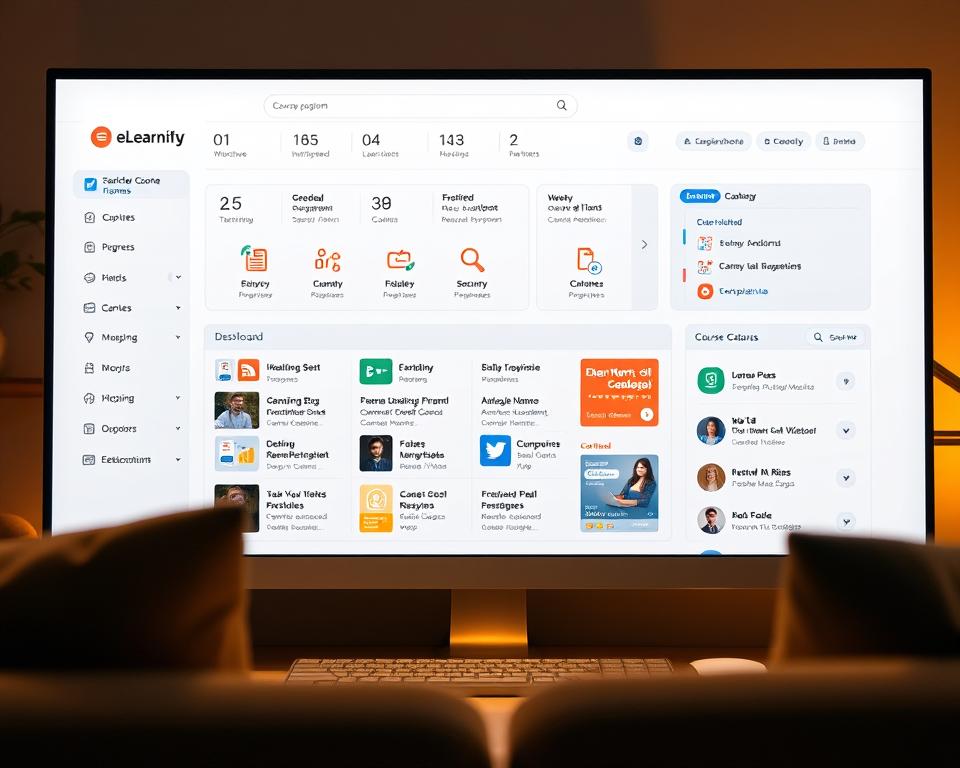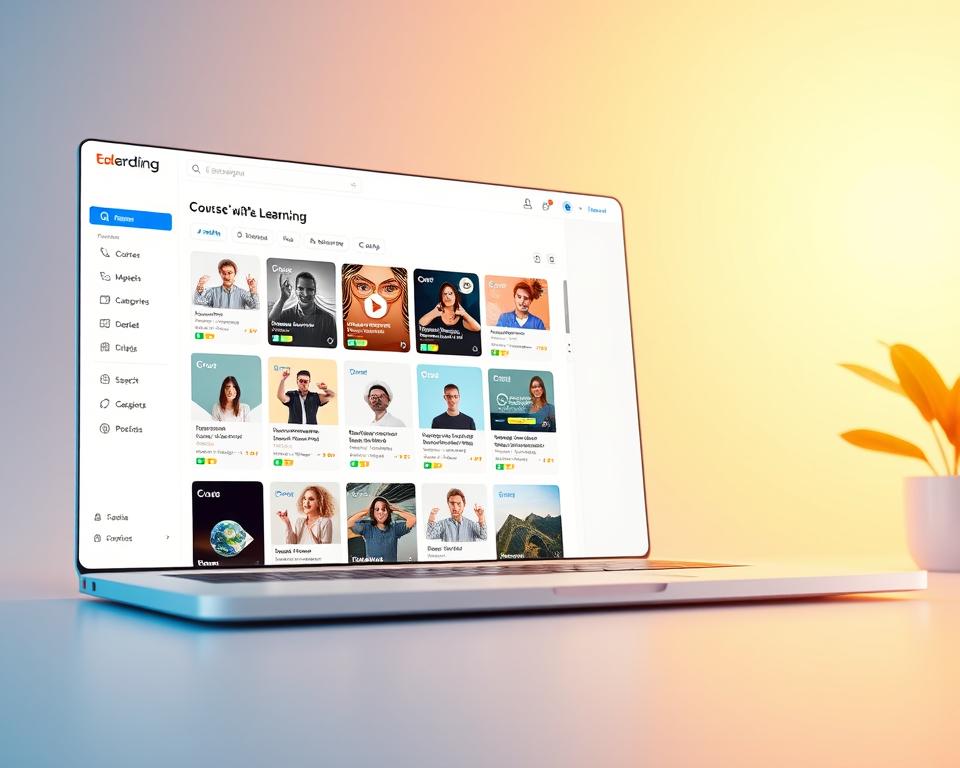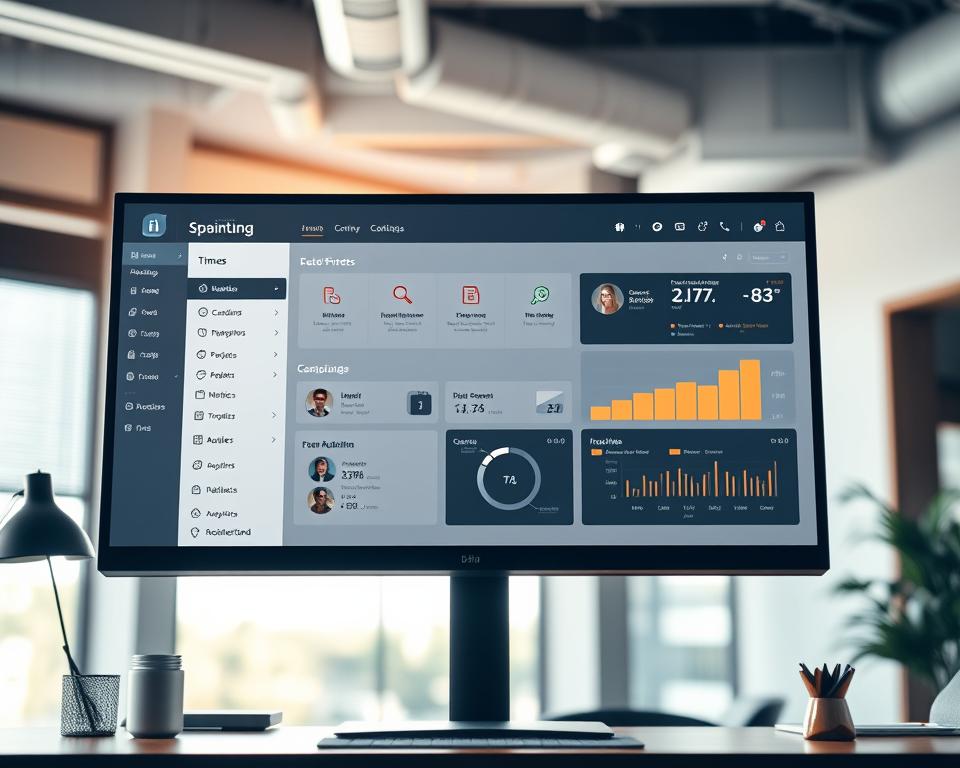To create an eLearning platform like Udemy or Coursera, you need to know the eLearning market well. You must understand what makes these platforms successful. Building an eLearning platform means making a place where lots of users can learn easily. Knowing the eLearning market is key to making a great eLearning portal.
If you’re a teacher wanting to reach more students or an entrepreneur starting a new eLearning site, this guide is for you. It will give you the basics to start with eLearning platform development and online education platforms.
Table of Contents
Introduction to eLearning Platform Development
This guide will take you through making an eLearning portal. We’ll cover understanding the market, its potential, and the technical and design needs for online education platforms.
Key Takeaways
- Understand the eLearning market and its potential for eLearning platform development
- Identify the features that make online education platforms successful
- Determine the technical requirements for your eLearning portal
- Design a user-friendly interface for your online education platform
- Develop a strategy for creating and managing courses on your eLearning platform
- Implement a payment gateway and revenue management system for your online education platform
Understanding the eLearning Platform Market
The eLearning market has grown a lot in recent years. This growth is thanks to new technology and how people like to learn now. To make a successful eLearning portal, knowing the market size, growth, and key players is key. Online learning platforms are getting more popular, so keeping up with eLearning trends is important.
Several factors are making the eLearning market grow. These include the need for flexible learning, new technology, and more people taking online courses. It’s vital to keep up with eLearning trends as the market changes.
To get a better grasp of the eLearning platform market, analyzing its size and growth is helpful. Look for the latest reports and studies on eLearning. Also, stay informed about new developments and trends in online learning platforms.
Essential Features of Successful eLearning Platforms
A top eLearning platform, like Udemy or Coursera, has key features that make learning better. They use a learning management system for easy access to courses. Also, educational technology is vital for interactive learning tools.
Some important features of these platforms are:
- User-friendly interface
- Wide range of courses
- Interactive learning tools
- Robust learning management system
These features help create a great learning space. The use of educational technology
Technical Requirements for Platform Development
Creating an eLearning platform requires careful planning. You need to pick the right technology stack and ensure your infrastructure can grow. It’s also key to think about scalability for more users and data.
Building an online course platform is complex. It needs a strong foundation to work well for everyone. A good platform makes learning easy for both teachers and students. So, investing in the best technology and infrastructure is crucial.
Key Considerations for Platform Development
- Selecting a suitable technology stack that can support the platform’s growth
- Ensuring adequate infrastructure to handle increased traffic and data storage needs
- Implementing scalability considerations to ensure the platform can grow with the user base
Knowing these technical needs helps developers make a solid eLearning platform. This platform can handle more users and courses, improving the learning experience.
User Interface and Experience Design
When making an eLearning platform, user experience design is key to success. It should be easy to use, navigate, and offer a smooth learning journey. To get this right, focus on eLearning platform usability and make sure it works well on all devices.
Responsiveness is a big deal. The platform should work well on desktops, laptops, tablets, and phones. This lets learners study whenever and wherever they want, with a consistent experience.
Accessibility is also crucial. The platform must work for all learners, including those with disabilities. Adding features like closed captions and high contrast mode helps a lot.
Personalization is essential for a great learning experience. It means making the platform fit each learner’s needs and likes. Using data, it can suggest learning paths and offer feedback, improving results.
Some important things to think about for user interface and experience design are:
- Clear and simple navigation
- Easy-to-use search
- Fun and interactive content
- Regular updates and ways to give feedback
By focusing on user experience and usability, you can make a learning space that’s engaging and effective. It will meet your learners’ needs and stand out from others.
Core Components of an eLearning Portal Like Udemy or Coursera
Creating an eLearning platform requires focusing on key elements for a smooth experience. Online course creation is vital, allowing instructors to manage their courses well. A good system should have tools for creating courses, managing assessments, and grading.
A key eLearning platform feature is user authentication and profile management. This ensures users can safely access their accounts and manage their profiles. It’s important for a secure and personalized learning experience.
Payment gateway integration is also crucial. It makes buying courses secure and easy. This includes options for payment, how to share revenue, and keeping financial information safe. These elements help build a strong eLearning platform, offering a great experience for users.
Content Management System Development
A well-designed content management system is key for an eLearning platform’s success. It makes managing and sharing educational content easy. This ensures users get the latest and most relevant info. A learning management system is a big part of this, helping teachers create and track courses. It also makes learning smooth for students.
Good content management has several important features. These include:
- Course creation and editing tools
- Content uploading and hosting
- Access control and user management
- Analytics and reporting
These features help teachers manage their content well. They also give insights into how users are doing and what they’re learning.
Building a strong content management system is crucial. It keeps content organized, easy to find, and engaging. This leads to happier users, better learning, and success for the platform.
Video Streaming Infrastructure Setup
For eLearning platforms that use a lot of video, a strong video streaming setup is key. This setup is crucial for a smooth learning experience. A solid video streaming infrastructure is vital for a top-notch eLearning platform development.
A good video streaming infrastructure has a reliable hosting solution, manages streaming quality well, and uses a strong CDN. These parts work together to make sure video content plays smoothly for users.
When setting up a video streaming infrastructure, consider a few things:
- Scalability: It should handle lots of users and video content.
- Reliability: It must deliver video content smoothly and without breaks.
- Security: It should protect video content and keep user data safe.
Investing in a strong video streaming infrastructure and following best practices for eLearning platform development will give your users a great learning experience. This will help you stay competitive.
Security Measures and Data Protection
Keeping user data safe is a big deal for online learning platforms. It’s important to use strong eLearning platform security to protect this data. This means encrypting important info, using safe ways to send data, and controlling who can access it.
Keeping data safe from hackers is also key. You can do this by backing up data, using secure storage, and checking for weak spots often. By focusing on eLearning platform security and data safety, you can make your users trust you more.
Here are some ways to keep your eLearning platform safe and your data protected:
- Implementing strong access controls and ways to check who you are
- Using encryption and safe ways to send data
- Doing regular security checks and tests
- Teaching users and admins about staying safe online
By taking these steps, you can keep your eLearning platform safe and your users’ data secure. This will help you gain their trust and keep your platform’s good name.
Payment Processing and Revenue Management
Payment processing and revenue management are key for an eLearning platform’s success. A good system makes transactions smooth, so everyone gets paid right. It’s important to look at different payment gateways like Stripe, PayPal, or Authorize.net. They are safe and reliable.
For revenue management, a fair way to share money is crucial. This means instructors get a part of the course sales, and the platform owner gets a cut. Revenue management also looks at how much courses cost, any discounts, and promotions to make more money.
- Secure payment gateways to protect sensitive user information
- Flexible revenue distribution models to accommodate different instructor and course requirements
- Regular financial reporting and analytics to track earnings and expenses
With a strong payment and revenue system, eLearning platforms can offer a great experience. This makes instructors happy and helps the business grow. It’s all about goodpayment processing and revenue management.
Instructor Dashboard Development
Creating a detailed instructor dashboard is key for an eLearning platform’s success. It should give instructors tools to manage courses, track student progress, and talk to learners. The dashboard must include features like course creation, student management, and tracking performance.
Some important features of an instructor dashboard are:
- Course creation and management
- Student enrollment and management
- Performance tracking and analytics
- Communication tools for interacting with students
These features help instructors manage their courses well. They also ensure a quality learning experience for students. By adding these features, eLearning platforms support their instructors and improve learning experiences.
A good instructor dashboard lets instructors track student progress and see where students need help. Analytics and reporting tools give insights into student performance. This helps instructors improve their teaching and student results.
Moreover, an instructor dashboard lets instructors create and manage their own courses. This boosts instructor engagement and motivation. By giving instructors the tools they need, eLearning platforms create a supportive learning environment for everyone.
Student Learning Interface Creation
The student learning interface is key in an eLearning platform. It greatly affects how learners experience education. A good eLearning platform development focuses on making this interface user-friendly and engaging. It should let learners move through courses smoothly and track their progress easily.
When making a student learning interface, think about what learners want. This means doing research and listening to what learners say. By doing this, developers can make an interface that meets learners’ needs, making learning more effective and fun.
Progress Tracking Features
Features that track progress are vital. They help learners see how they’re doing and stay motivated. These can include personalized learning plans, progress bars, and badges for completing courses or reaching milestones.
Assessment Tools
Assessment tools are also crucial. They let learners check their understanding of the course. Tools like quizzes, exams, and assignments give feedback on how well they’re doing.
Interactive Learning Elements
Interactive elements, like videos, simulations, and games, make learning more engaging. They can be added to the interface to make the learning experience more immersive and fun.
Mobile Application Development Strategy
Creating a mobile app for an eLearning platform is a smart move. It lets learners access courses anytime, anywhere. Mobile application development focuses on making the app easy to use and fun to interact with.
A good mobile app makes learning more fun and easy. Key things to think about include:
- Ensuring it works on many devices and systems
- Adjusting content for small screens and mobile internet
- Adding features like push notifications and offline access
By making an eLearning platform mobile, teachers can reach more people. Learners get more freedom to study when they want. This can also make them more interested and likely to stick with it.
When making a mobile app for an eLearning platform, think about what users need. This means mobile application development that fits the platform and its users well.
Analytics and Reporting Systems
Creating a detailed analytics and reporting system is key for an eLearning platform’s success. It helps developers understand user behavior and track important metrics. This way, they can make smart choices to improve the platform.
In eLearning, analytics and reporting are essential. They help see how users interact with the platform. This info helps improve the user experience and boost engagement.
Key Performance Metrics
Important metrics to watch in eLearning platform development include:
- User enrollment and completion rates
- Course engagement and interaction metrics
- Revenue and payment processing metrics
User Behavior Analysis
Understanding user behavior is crucial. It shows how users move through the platform, what they use most, and where they struggle. This insight helps developers make the platform better.
By adding analytics and reporting to eLearning, developers can make learning more enjoyable and effective. This leads to happier users, better learning results, and more revenue.
Marketing and User Acquisition Strategies
Creating effective marketing strategies is key for an eLearning platform’s success. It’s important to use a mix of strategies to attract and keep users. This includes social media marketing, content marketing, and paid advertising. These methods help eLearning platforms grow their user base and online presence.
A good marketing strategy should make engaging content and build a strong brand. It also needs to offer value to users. This can be done through different channels, like:
- Social media platforms
- Email marketing campaigns
- Influencer partnerships
- Content marketing initiatives
By using smart marketing strategies and focusing on user acquisition, eLearning platforms can become more visible. They can also drive more traffic and grow their user base.
Platform Maintenance and Support Systems
Creating an eLearning platform is a continuous effort. It needs ongoing platform maintenance to stay stable, secure, and working well. This means regular updates, fixing bugs, and making the platform faster. By focusing on support systems, you can cut down on downtime, gain user trust, and boost satisfaction.
A good eLearning portal development plan should cover maintenance and support. This might include setting up tech support, managing updates, and helping users. Important parts of platform upkeep and support are:
- Regular software updates and security patches
- Performance monitoring and optimization
- User feedback and support systems
- Content updates and refreshes
Investing in platform maintenance and support systems keeps your eLearning platform ahead. It stays secure and offers a great user experience. This can lead to more users, better retention, and higher revenue.
Conclusion
Creating an eLearning platform like Udemy or Coursera is a big challenge. It needs a deep understanding of the online education market, technical skills, and a focus on making the user experience great. By following the tips and best practices in this article, you can start building a strong and lasting eLearning platform. This platform will meet the changing needs of your audience.
Every step in building a eLearning platform is important. From defining key features to making sure the tech works well, each part matters a lot. By focusing on user experience, managing content, streaming videos, keeping things secure, and using analytics, you can make a platform that attracts learners. It also helps instructors and administrators do well in the fast-changing online education world.
When you’re working on your eLearning platform, be ready to change and improve. By using the best practices and insights from this article, you can make your eLearning platform the best it can be. It will become a top place for quality online learning.



















